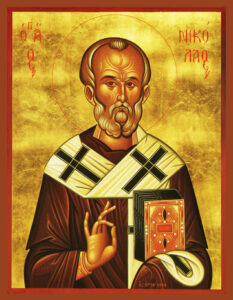
Everybody knows Saint Nicholas belongs in December – so what is he doing here in May?
It’s because May 9 is a lesser and almost unknown feast day of Saint Nicholas, the day when… we’ll come to that. Keep reading.
Over the past few years, I have sometimes referred you back to old posts about Saint Nicholas, but I think I’ve not written anything fresh about him for quite a while. It’s time to correct that.
Nicholas is one of our Lord’s most “potent” saints – is that the right word? and someone I personally revere. He is officially titled “Saint Nicholas the Wonderworker”, because he can do remarkable things which fill people with wonder.
Some of you who are new to this Blog may not know the full story of Saint Nicholas, and we old-timers need to hear it again so we don’t forget.
Therefore:

I’m sure you all know that Saint Nicholas is the origin of that man who still wears the red outfit of our patron saint, albeit considerably adulterated – that mythical man who, long ago when I was young was still a mysterious magical figure, but lately has turned to selling cars and what not on TV: Santa Claus.
Oh, I do hate to tell you this but, despite that poem, Saint Nicholas is not a Norse myth who comes from the North Pole. ( He’d have a tough time trying it these days, when global warming is rapidly melting the ice under the elves’ workshops.)
He’d have a tough time trying it these days, when global warming is rapidly melting the ice under the elves’ workshops.)
Here’s the truth about him:
Santa Claus was Greek. Saint Nicholas (reverting to his proper name) was Bishop of the city of Myra, a seaport on the south coast of Asia Minor, in what is now Turkey. In the Fourth Century, Myra was Orthodox Christian and Greek, both in culture and in language.
- It is depressing to remember that what is now Turkey was once the spiritual, theological and cultural center of Christianity.
Nothing was recorded directly about Bishop Nicholas’ life. We have only stories passed down as the people of Myra remembered him, probably elaborated and smoothed out a bit over the years. However, they tell us about the character of the man.
The stories:
1 Three girls came from a family so poor that they had no dowry with which to “buy” a husband, so to speak. When they came of age, they would likely have go to into, um…, an unacceptable profession to keep from starving to death. But when the first came of age, in the morning they found a bag of gold on the floor. Likewise with the second. With the third they were prepared, and they caught a man about to throw another bag of gold in the window. The man was their Bishop Nicholas.
2 Child abuse existed also in the ancient world. For some reason an innkeeper had gone into a rage and battered three boys, then hid them in a pickle barrel, either dead or barely alive. Somehow Bishop Nicholas found them and restored them to life.
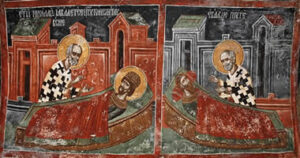
3 Three soldiers (or some say generals) from Myra had been unjustly arrested and were to be executed the next morning, until … here is a verse sung on the feast of Saint Nicholas: “You appeared in a dream to the Emperor Constantine and his counselor Avlavius, speaking to them, and putting them in fear: ‘Set free at once those you hold unjustly bound in prison, for they are not guilty of lawless murder! And if you do not listen to my words, O King, I will beg the Lord and intercede against you!’” Pow! Can you imagine a saint praying against you? Next morning they were set free.
4 Myra was suffering a severe drought and people were going hungry, until Nicholas appeared *to the captain of a ship carrying grain across the Mediterranean, and caused him to turn into Myra.
- He apparently was one of saints who have the power of “bi-location”. I’ve read of one in the Twentieth Century.
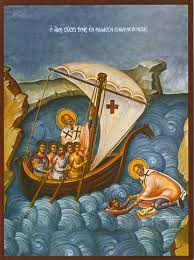
5 This may have taken place after Saint Nicholas’ death: A ship was caught in a storm and about to founder, until people called on Nicholas for help, and immediately the storm ceased. That is pictured in many icons of Saint Nicholas.
6 There are many more stories, but the best-loved of them all is of Saint Nicholas at the First Ecumenical Council which was held in the year 325 at Nicaea in northwest Asia Minor. Bishops came from near and far, and their names were recorded. How odd that the name of Bishop Nicholas of Myra is not on the list.
According to the story, here is why: The Council was called by Emperor Constantine primarily to deal with the question of Arianism and its source, the priest Arius of Alexandria. Arius was teaching that Jesus was not God Incarnate, but only a man who had been created by God – and he was spreading this teaching all over the empire.
To do so, Arius appears to have invented the singing commercial, and if so, may God forgive him this, too. He had little bands of musicians going all about singing songs like this: “He who was not created … made the son as the first created being…he is not equal to God nor has he the same being as God….” (Well, you had to be there.)
The line that captured everybody’s attention was this: “There was a time when the son was not”. It caught on. And as is horrifyingly obvious today, if you just say something often enough – be it true or utterly, demonstrably false – many people will believe it.
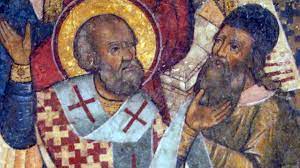
Now, this is the story that has been passed down. When Arius got up at the Council and began to sing his songs, Bishop Nicholas was so horrified, so angered that he went over and punched him a good one, and thereby got himself thrown out of the Council. And that’s why Nicholas of Myra is not listed as one of the bishops present at the First Ecumenical Council. This episode has been the source of many little dramas and Sunday School pageants over the years. We had a great one some years ago at Saint Nicholas, Cedarburg, which stole the show.
Oh, I almost forgot: The final vote at the Council was apparently Arians 2, Orthodox 315 . (It would have been 316 if Nicholas hadn’t got kicked out.)
Bishop Nicholas of Myra died on December 6, about the year 343.
His people remembered him as a holy man, a man who was extraordinarily loving, clever, tough, who could work wonders, who cared deeply about his people, was strictly Orthodox in doctrine. A saint. Before his death they had often asked his prayers, and amazing things happened. After he died they kept doing so, and amazing things continued to happen.
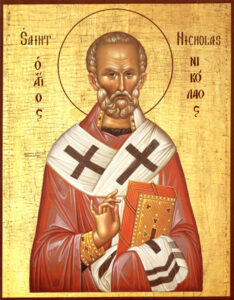 How do we know for sure that people remembered their Bishop Nicholas as a saint? Because they always commemorated him on December 6. In the Church saints have always been remenbered on the day of their death, their entrance into Heaven. As far back as we can look, in Myra and also in many places fanning out from Myra, Saint Nicholas has been commemorated always on December 6.
How do we know for sure that people remembered their Bishop Nicholas as a saint? Because they always commemorated him on December 6. In the Church saints have always been remenbered on the day of their death, their entrance into Heaven. As far back as we can look, in Myra and also in many places fanning out from Myra, Saint Nicholas has been commemorated always on December 6.
Nicholas was one of those saints who did his best work after he died. As far back as we can look, Myra was a place of pilgrimage, because of miracles of all sorts attributed to Saint Nicholas, and also because of something else very remarkable:
From the time of his death, Saint Nicholas’ body began to exude a pure liquid which had healing properties. He was one of the Church’s few “Myrrh-Streaming Saints”. (Saint Demetrios was another.) People called it myrrh, for lack of a better word. “Myrrh from Myra!” they used to say. How do we know that really happened? Because the body of Saint Nicholas still exudes that myrrh. I have some of it, which I got (for a price) many years ago when I visited him in Bari in far southern Italy.
Saint Nicholas in Italy
What is he doing in Italy? That’s what his feast day on May 9 is all about. In the Eleventh Century, some merchants from Bari went by ship to Myra, told the residents they’d had a vision commanding them to take the body of Saint Nicholas back to Bari. According to the story, the residents of Myra said “Yes, yes, take our patron saint away.” (Now tell me another one.) Personally, I think visions had nothing to do with it. I think the merchants of Bari saw a good money-making project.
However, it was for the best. Because of pirates and Saracen raids in the eastern Mediterranean, as well as the the rapid spread of Islam, pilgrimages to Myra had almost ceased, and the body of Saint Nicholas was in some danger. Bari was safely to the West, and at the time southern Italy was still Orthodox.

Saint Nicholas was received in Bari with much pomp and circumstance, and they certainly treated him well: They laid him in the crypt of a beautiful new San Nikola Basilica, near the shore of the Adriatic – and there he still lies. Over the last millennium countless pilgrims, including me, have come to Bari – and, of course, because of that the city of Bari has prospered ever since.
Another good thing came out of Saint Nicholas being brought west. Devotion to him, which had previously been confined mostly to the eastern Mediterranean, now spread all over western Christendom, as well. There were more churches in England named after Nicholas than any other saint. Likewise in Russia – I don’t know the story of how he got to Russia.
If you search online you can find a multitude of miracles and wonders attributed to him, and even a few weeping icons of Saint Nicholas: one only a few years ago in Michigan City, Indiana, of all places. One of his minor miracles, I believe, is the existence of Saint Nicholas Church, Cedarburg, Wisconsin. We’ll look at that next week.
Back in Bari, Saint Nicholas still exudes the myrrh. Priests open his coffin every year on his feast days and remove some of the fresh myrrh, then dilute it and sell it. (I think Orthodox would probably give it away, but that’s neither here nor there.)
I read that Nicholas’ body is still in pretty good shape for someone 1700 years old, despite the fact that small pieces of his bones (relics) have been distributed throughout the world. (We have a relic of Saint Nicholas implanted in our altar at Saint Nicholas Church, Cedarburg – a gift from Father Thomas Hopko of greatly blessed memory. I don’t know where he got hold of it.)
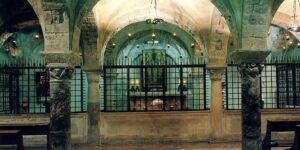
The crypt where Nicholas lies is a holy place. The feel of it hung over me for days after I was there – and still today, as I write about it.
 Southern Italy is now Roman Catholic territory, but the Archbishop of Bari allows an Orthodox chapel just to the left of the crypt where Saint Nicholas lies. I was there on a Sunday morning. Perhaps 75 people were praying quietly … and then I heard something familiar. It was the Orthodox Divine Liturgy being celebrated in the chapel – in Italian. God bless the Roman Catholic Archbishop of Bari.
Southern Italy is now Roman Catholic territory, but the Archbishop of Bari allows an Orthodox chapel just to the left of the crypt where Saint Nicholas lies. I was there on a Sunday morning. Perhaps 75 people were praying quietly … and then I heard something familiar. It was the Orthodox Divine Liturgy being celebrated in the chapel – in Italian. God bless the Roman Catholic Archbishop of Bari.
Next Week: I know many of you have heard this story before. Humor me. I love to tell it. How Saint Nicholas founded Saint Nicholas Orthodox Church in Cedarburg, Wisconsin
Week after Next: And now for something completely different – Blessed Musa of Rome and Saint Brendan the Navigator